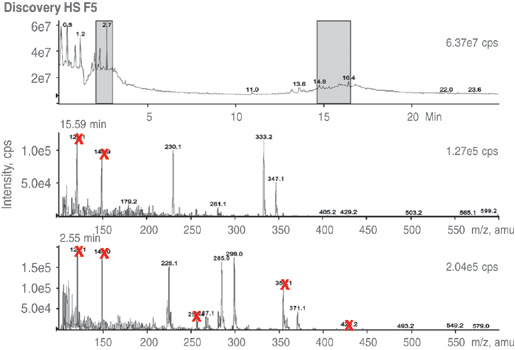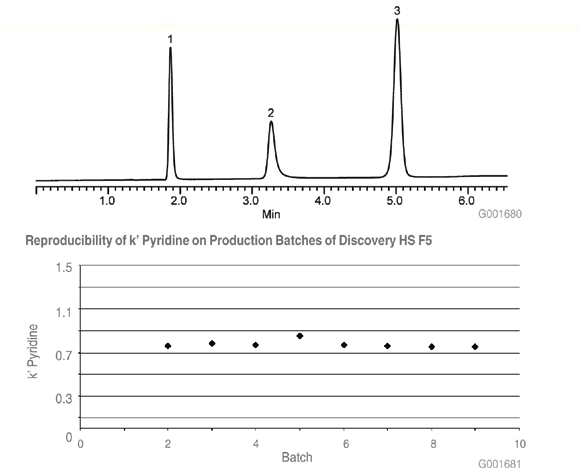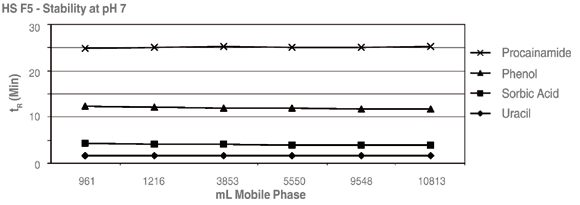HPLC Discovery HS F5
Discovery Silica-Based Phases Discovery HS F5

Unique Retention and Selectivity Enables Better Separations
The Discovery HS F5 bonded phase provides reversed-phase separations that are distinctly different from C18 columns. However, compounds will generally elute within the same retention time window, making most C18 methods easily transferable.
Discovery HS F5 Delivers...
- Unique selectivity
- Excellent peak shape
- Stable, low-bleed LC/MS separations
- Reproducible column performance
- Scalable separations from 3 to 10µm
- Both reversed-phase and HILIC modes
- Possesses multiple types of interactions: dispersive, dipole-dipole, π-π, charge-transfer
Key Applications
Small, water soluble molecules and peptides, polar compounds, basic compounds, positional isomers
Notes
- Compared to a phenyl phase: Although aromatic in nature, the pentafluorophenylpropyl (F5) phase does not resemble a phenyl phase in retention or selectivity. The F5 is a strong Lewis acid due to the electron withdrawing effects of five fluorine groups; the F5 ring is electron deficient whereas the phenyl ring is electron rich.
Guidelines for Transferring a C18 Method to Discovery HS F5
Generally, bases are longer retained on the HS F5 than on a C18. Increasing the organic content of a C18 separation 5 to 10 percent will generally provide similar retention on a HS F5. Results with other compounds are highly variable. However, it is generally true that solutes with logPo/w values less than 2.5 will be retained longer on HS F5 compared to a C18. The degree of difference is highly solute dependent.
The Discovery HS F5 shows greater retention (Table 1), versus C18, of the multifunctional compounds shown in these chromatograms. Compounds that elute too closely to the void volume (peak 1) on C18 columns are sufficiently retained by Discovery HS F5 (Table 2).

Figure 1. Excellent Retention of Multifunctional Compounds

Figure 2.Discovery HS F5 Provides Excellent Separation - Solutes Are Not Retained on C18
Discovery HS F5, a unique, functionalized reversed-phase uncovers a trace impurity in quinidine missed by C18. Neat quinidine was assayed on C18 under a variety of mobile phase conditions (Table 3). Conditions C and D produced a single peak suggesting the quinidine was pure. The peak resulting from condition B might be showing partially resolved front shoulder. A quick screen of % organic was unable to resolve the possible impurity. On the HS F5 (chromatogram A), the impurity is clearly resolved. During method development a quick screen using unique, functionalized reversed-phases such as Discovery HS F5, greatly increases the chances of finding trace impurities early, before they can cause potentially large problems.
In Table 4, cytidine and related compounds provide another example of the power of HS F5 to provide unique and valuable separations compared to a C18. An added benefit of the HS F5 is its resistance to phase collapse under 100 % aqueous conditions.

Figure 3. Discovery HS F5 Resolves Trace Impurity in Quinidine – C18 Does Not.
Figure 4. Unique Selectivity of Discovery HS F5 Resolves Compounds Better than C18
LC/MS Compatibility
Stable Bonded Phases Suitable for LC/MS
The Discovery HS F5 shows low acceptable bleed after three conditioning cycles as verified by an independent testing laboratory (1). The data shows the averaged mass spectra obtained from the designated (shaded) regions of the total ion chromatogram (Figure 5). A blank was also run, that is, the same conditions used with the column in-line were run after removing the column and replacing it with a zero dead volume union.
The X’s on each mass spectrum indicate the mass found both in the blank run and in the run containing the column. Note that many of the major masses are accounted for in the blank when comparing it when the column was installed. This indicates low, acceptable bleed coming from the Discovery HS F5 phase.
HS F5 exhibits low bleed after just 3 conditioning cycles. Note also the aggressive mobile phase used for this test.

Figure 5. Unique Selectivity of Discovery HS F5 Resolves Compounds Better than C18

Above LC/MS results obtained from Dr. Shane Needham, Laboratory Director, Alturas Analytics, Inc. Moscow, ID, an independent testing laboratory.
Reproducible Column Performance
Durable, Reproducible Columns Minimize Downtime for Column Replacement and Troubleshooting
An important factor for developing a robust analytical method is column reproducibility. Column selectivity should remain the same and the elution patterns of the proteins or peptides must be reproducible. Consistency in silica and bonded phase chemistry guarantees that Discovery columns have exceptional reproducibility between injections, columns, and bonded phase lots (Tables 6 and 7).

Figure 6. Reproducibility

Figure 7. Column Lifetime

Figure 8.Good Stability at pH 7
Scalability
Scale-Up to Preparative; Scale-Down to High Speed or Narrowbore Separations
Bonded phase and silica chemistry are uniform across all Discovery particle sizes.
Precious samples can be wasted during scale-up if the analytical and preparative columns do not give the same elution pattern.
Analytical separations that are developed on Discovery 3 or 5 micron particles are completely scalable to preparative separations on Discovery 10 micron particles and larger columns. Additionally, separations developed on 5 or 10 micron particles can be scaled down for fast analysis on 3 micron particles.
- Discovery 10 micron particles in large column dimensions are ideal for isolating and purifying mg to gram amounts of compounds for further characterization.
- Discovery 3 micron particles in short columns are ideal for rapid analysis and LC/MS applications.

Figure 9. Procainamides on Three Particle Sizes of Discovery HS F5
Applications & Publications
Application Notes
Application Reports
T003001 #01 - Analysis of Tetracycline Antibiotics on Discovery HS F5
T003030 #30 - Analysis of Amphetamines on Discovery HS F5
T003032 #32 - Analysis of Norepinephrine Metabolites on Discovery HS F5
T003033 #33 - Analysis of Norepinephrine and 3,4-dihydroxyphenyl glycol on Discovery HS F5
T003039 #39 - Analysis of Biogenic Amines on Discovery HS F5
T003040 #40 - Analysis of Selegiline and its Amphetamine Metabolites on Discovery HS F5
T003046 #46 - Drugs of Abuse on Discovery HS F5
Bulletins
Publications
T403121 Advantages of Polar Reversed-Phase Chemistries for LC/MS Analyses, David S. Bell

To continue reading please sign in or create an account.
Don't Have An Account?